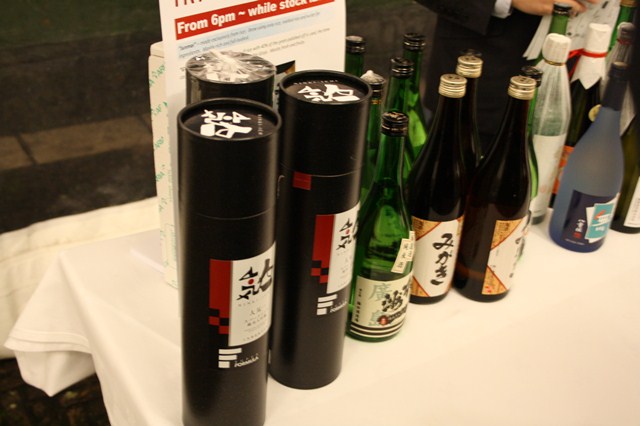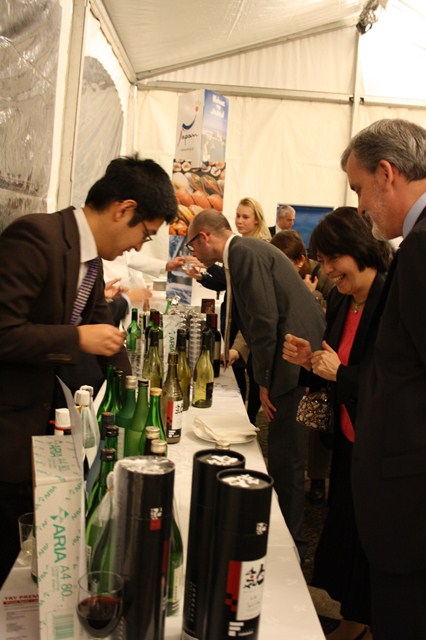
O-MO-TE-NA-SHI Again; The World of Sake (No.10) Part 1
25th of February 2015
 In the last LFB, I talked about hospitality (O-MO-TE-NA-SHI) by serving sake at the Ambassador’s residence, and because I received some reactions, I would like to have a special edition on sake this time as well as next time. In the last LFB, I talked about hospitality (O-MO-TE-NA-SHI) by serving sake at the Ambassador’s residence, and because I received some reactions, I would like to have a special edition on sake this time as well as next time.
It is possible to enjoy sake without any complicated lectures, but I would like to share some “mini knowledge” (trivia) here below, as a reference.
Sake is a brewed beverage made from rice and the production process is similar to that of wine. I sometimes hear the misunderstanding that sake contains a high percentage of alcohol, but this is not the case. The alcohol level of sake is on average between 15 and 16 percent, which is only slightly higher than that of wine which is between 12 and 13 percent. Recently, wine, and particularly red wine containing 15 percent is sold, so in conclusion I think it might be best to consider wine and sake as being very similar.
Next, ingredients. To make delicious sake, it is said that water, rice, yeast and the brewer are the four important factors.
 The rice that is the base of the sake (sake rice) is somewhat different from that of rice used for eating. In order to shave off the outside of the rice grain without splitting its core, the grain which is used is slightly bigger than regular rice. No matter which kind of rice, the core is white and opaque, is very sticky and contains little protein. Its properties are easily lost because of its solubility in water, and the core of sake rice is larger than average. The most well-known sake rice nowadays must be “Yamada Nishiki”. Within the category of sake rice its production is the largest. The sake made from this rice generally has a good aroma and is often used for making Daiginjo sake. On the other hand, sake rice varieties from the Tohoku area like “Gohyakumangoku” and “Miyamanishiki” are also famous. The taste of sake made from this rice is fresh and smooth. Furthermore, “Dewasansan” variety, a special product of the Yamagata prefecture, is used in ginjo sake and has a clear-cut flavor. Another one is “Omachi”. This sake rice has the longest history and was once about to go extinct but recently there has been a revival. Flavor wise, a sake with a lot of body and aroma can be made from it. The rice that is the base of the sake (sake rice) is somewhat different from that of rice used for eating. In order to shave off the outside of the rice grain without splitting its core, the grain which is used is slightly bigger than regular rice. No matter which kind of rice, the core is white and opaque, is very sticky and contains little protein. Its properties are easily lost because of its solubility in water, and the core of sake rice is larger than average. The most well-known sake rice nowadays must be “Yamada Nishiki”. Within the category of sake rice its production is the largest. The sake made from this rice generally has a good aroma and is often used for making Daiginjo sake. On the other hand, sake rice varieties from the Tohoku area like “Gohyakumangoku” and “Miyamanishiki” are also famous. The taste of sake made from this rice is fresh and smooth. Furthermore, “Dewasansan” variety, a special product of the Yamagata prefecture, is used in ginjo sake and has a clear-cut flavor. Another one is “Omachi”. This sake rice has the longest history and was once about to go extinct but recently there has been a revival. Flavor wise, a sake with a lot of body and aroma can be made from it.
Next is the yeast. Like in beer and wine, it has an important influence on the final aroma. In the past, yeasts naturally present in nature were, partly based on experience and partly by accident, captured and used for making sake. Brewers who have existed for a long time, have “brewers’ yeast”, natural yeast living on the walls and in the air which are cherished and used for making sake. Therefore, the location for making sake was important, moving to another place meant that the same flavor could not be reproduced. Along with the development of bio-chemistry, this situation has drastically changed. Nowadays, advanced tests are done in several places to obtain a specific flavor by making a specific yeast, or by selecting a yeast which will become the base for a specific flavor and blending it to achieve the desired flavor.
Next is the maker. Even in a time in which bio-chemistry has developed, the skills obtained through many years of experience have a big influence on the flavor. In the Edo period, with protection and support from feudal lords, in some districts, a few main domains groups of sake makers were created. Their skill is extremely valuable, and it is said that during the off-season periods they would accept requests and travel to faraway breweries and took part in making sake. Transporting people is easy, but nevertheless there are only a few regions which historically had a large number of sake brewer masters.
Next and final is good water. When visiting a sake brewery, spring water which is used for sake making can often be taken home. It may be just a feeling, but I find that water used for making sake has a mild and delicious flavor. Lately, sometimes people appease their thirst with water for making sake (it’s called “shikomimizu”) and then drink sake made with the same.
To put the above in a simple way, nowadays rice can be selectively bred and exported. Like I mentioned, yeast can be scientifically made and the brewer can also be moved. However, only water, whatever way you do it, will be affected: by moving it it’s said that its smell will change. There are reasons to say that in order to make a good sake, you have to do it where you can get good water. However, when compared to the past, the range of places that meet the conditions to make a good sake has considerably expanded. Nowadays, it’s not an exaggeration to say that good sake can be found in any prefecture in Japan. I can understand that everyone has trouble choosing.
This being said, next time in part two, I would like to explain about the different kinds of sake and various flavor indicators. Stay tuned!
|

